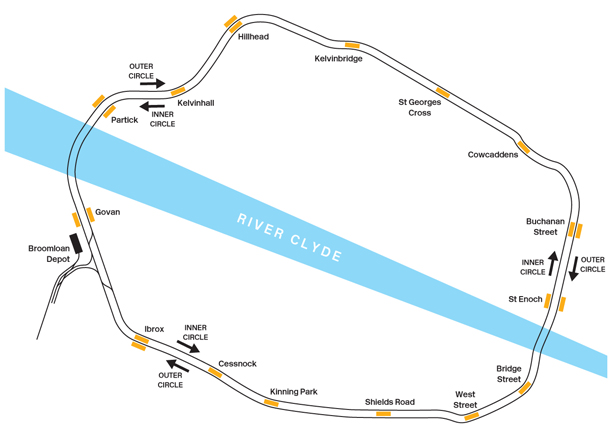Glasgow Subway is an add-on for Train Simulator Classic
The base Train Simulator Classic game is available separately from the Steam online store and is required to use this add-on DLC (Downloadable Content)
About the Glasgow Subway
Route Overview

The Glasgow Subway is the third-oldest underground metro system in the world after the London Underground and the Budapest Metro. Originally a cable driven railway, the subway was later electrified.
In 1936 it was renamed the Glasgow Underground, however many Glaswegians continued to refer to the network as "the Subway". In 2003, the name "Subway" was officially readopted by Strathclyde Partnership for Transport (SPT).
The subway system was constructed as a twin bore 6.5 mile (10.5 km) circular loop that runs north and south of the River Clyde. The track gauge is 4 ft. (1,219 mm) with a nominal tunnel diameter of 11 ft. (3.4 m). The Outer Circle and Inner Circle refers to the double track, having trains running clockwise and anticlockwise respectively around the same route in separate tunnels.
The subway's running lines are entirely underground with a maintenance depot at Broomloan Road between Govan and Ibrox. Prior to modernisation, trains were lifted by crane in to the depot above. Modernisation in 1980 brought the installation of points and access ramps where trains can now access the depot for storage and maintenance.
History
In 1891 The Glasgow District Subway Company began construction of the underground. The subway opened on 14 December 1896 as a cable railway with one single cable powering each circle. A steam-powered engine between West Street and Shields Road stations drove the cables. There were no points on the lines with no way to drive to the surface. Instead train vehicles were transferred to and from the running lines by a crane operating over a pit at the Govan depot.
All 15 stations were built with centre platforms so trains only required doors on one side of the vehicles. Glasgow Corporation took over the system in 1923 and in 1935 the existing trains were converted to third rail electric power. Before the 1977–1980 modernisation programme, the stations had a very distinctive smell and passengers were rocked forwards and backwards while the carriage 'shoogled' them around.
By the 1970s the stations were very dilapidated, there were no escalators and only Kelvinbridge had a lift. The use of the Subway had also declined, partly by the closure of some of the dockyards on the River Clyde. The original carriages dating back to 1896 were still in use and breakdowns were becoming increasingly frequent. In 1974 a modernisation programme was announced.
On the 21st May 1977 the system was shut down for major refurbishment and modernisation. Tunnels were repaired, stations were rebuilt and enlarged, with additional platforms at Buchanan Street, Partick, Govan, Ibrox, Hillhead and St Enoch. Heavier track was installed although still using the 4 ft. (1,219 mm) gauge, the original Broomloan Depot was modernised and equipped with connecting tracks with points to replace the crane and depot pit. A new ticketing system with passenger-operated ticket vending machines and automatic turnstile barriers was added. The modernised system also features automatic train operation (A.T.O.).
Key Features
- Complete 10km Glasgow Subway, which runs underground in a circle around the centre of the city
- Unique 4ft Gauge track system with 600V third rail
- 15 highly detailed stations, and Broomloan depot with animated shed doors and operating train washer
- Second Generation Glasgow Subway rolling stock in orange livery
- Custom-designed signalling and working A.T.O. (Automatic Train Operation)
- New random on-board passenger system to vary people inside the train vehicles
- Authentic cab and controls
- Realistic start-up and driving characteristics
- In-cab permissible speed lamps
- Multiple "extended cab" passenger view cameras with operable emergency stop handles
- 7 Career scenarios including guided tutorials for main train controls and A.T.O.
- Quick Drive Compatible
and much more!
